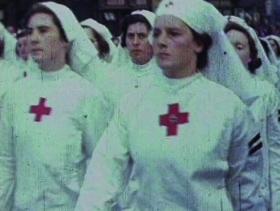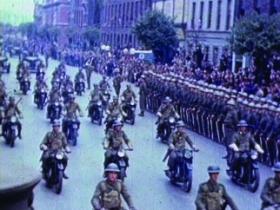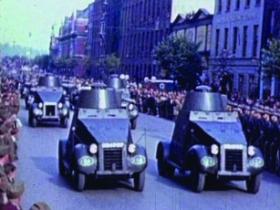Step Together
Published in 20th-century / Contemporary History, Features, Issue 3 (May/June 2010), The Emergency, Volume 18
Above and below: Scenes from the largest-ever military parade held in Ireland in Cork City on 13 September 1942. (Military Archives)
Interactives are an important part of modern museum exhibitions and there are 35 in the ‘Soldiers & Chiefs’ exhibition. Those dealing with the Irish Defence Forces are focused on films of the army in action lent to the museum by Military Archives and the Irish Film Archive. The first is a 1939 recruiting film, Step Together, made for the Volunteer Force, the reserve of the Irish Army which was created in 1934 to appeal to Fianna Fáil supporters and offer them an alternative to membership in the IRA. The film is nine minutes long and follows a young recruit joining the force, showing what he will be doing as a volunteer. Ironically, the film was made in a desperate attempt by the Fianna Fáil government to encourage new recruits, as there was a high turnover in members and the force never reached its manpower targets. During the Emergency, Movietone made eight newsreels about the Irish Defence Forces in 1942, covering subjects such as Éire’s Citizen Army in Training, Air Raid Protection Display, Aer Corps and The Marine Service. These are a fascinating insight into Irish society, in particular the last in the series: 1942, a year of sacrifice and achievement, which uses the other army newsreels to review the year as well as looking at social life in Ireland during the Emergency. It ends with a rousing speech by Éamon de Valera.
 While Movietone filmed professional newsreels, Major General MacNeill, commander of the Irish army’s 2nd Division, set up a film unit in 1942. What is interesting and rare about this footage is that, although there is no sound, it is filmed in colour rather than in black and white. Topics include the Blackwater exercises that took place over two weeks in Munster in August 1942, followed by the largest-ever military parade held in Ireland in Cork City on 13 September. In relation to the National Museum of Ireland, there is a very interesting film of the standing down of the 26th (Old IRA) Battalion of the Local Defence Forces at the end of the Emergency in Collins Barracks. Oscar Traynor, the IRA Dublin commander during the War of Independence and then minister for defence, inspected the battalion, which consisted of volunteers who had fought during the War of Independence and had joined the army during the Emergency. HI
While Movietone filmed professional newsreels, Major General MacNeill, commander of the Irish army’s 2nd Division, set up a film unit in 1942. What is interesting and rare about this footage is that, although there is no sound, it is filmed in colour rather than in black and white. Topics include the Blackwater exercises that took place over two weeks in Munster in August 1942, followed by the largest-ever military parade held in Ireland in Cork City on 13 September. In relation to the National Museum of Ireland, there is a very interesting film of the standing down of the 26th (Old IRA) Battalion of the Local Defence Forces at the end of the Emergency in Collins Barracks. Oscar Traynor, the IRA Dublin commander during the War of Independence and then minister for defence, inspected the battalion, which consisted of volunteers who had fought during the War of Independence and had joined the army during the Emergency. HI
Lar Joye is curator of military history at the National Museum of Ireland (Decorative Arts and History).
 Sample clips on our web site: https://www.historyireland.com/
Sample clips on our web site: https://www.historyireland.com/
For more on newsreels and films from the 1930s and 1940s:
Irish Film Archive: http://www.irishfilm.ie/archive/
RTÉ Libraries and Archives: http://www.rte.ie/laweb/arc/arc_index.html
Movietone Newsreels: http://www.movietone.com/
British Pathé Newsreels: http://www.britishpathe.com/
















